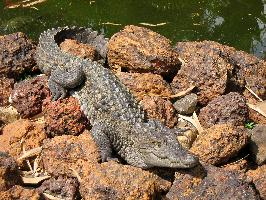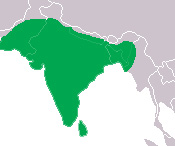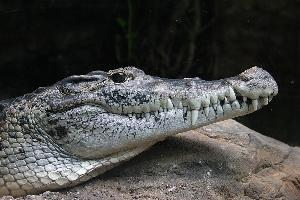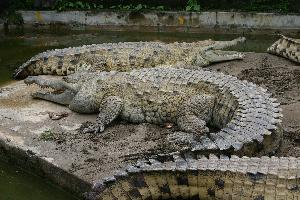
Poids et mesures
| Longueur | de 4 à 5 m |
|---|
Statut de conservation
| Menacé |
Description de l'animal
The Mugger crocodile (Crocodylus palustris), also commonly known as the marsh crocodile, is a fascinating and formidable reptile native to freshwater habitats across the Indian subcontinent, including India, Pakistan, Nepal, and Sri Lanka. This species distinguishes itself from other crocodiles with its broad snout and a somewhat more tolerant behavior towards its own kind, often seen basking in groups.Mugger crocodiles are sizable creatures, with adult males typically reaching lengths of about 3.5 meters (11.5 feet), although some individuals have been reported to grow up to 5 meters (16 feet). Females are generally smaller. Their bodies are robust and powerful, covered in dark olive or brown scales, with a rugged hide that provides excellent camouflage in their murky, aquatic environments. The snout of the Mugger crocodile is broad and slightly rounded, equipped with sharp teeth designed for gripping onto slippery prey.
One of the most remarkable features of the Mugger crocodile is its adaptability to various freshwater habitats. It can be found in lakes, rivers, marshes, and even man-made reservoirs. This adaptability is a key factor in the survival of the species, allowing it to thrive in diverse environments. Despite this adaptability, the Mugger crocodile faces threats from habitat destruction, pollution, and entanglement in fishing equipment, which have led to a decrease in its population in some areas.
The diet of the Mugger crocodile is varied and opportunistic. It primarily feeds on fish, but it also preys on birds, reptiles, and small mammals that come close to the water's edge. Larger individuals have been known to take down larger prey such as deer. The hunting strategy of the Mugger involves lying in wait, partially submerged or completely underwater, before launching a swift attack on unsuspecting prey.
Reproduction in Mugger crocodiles involves elaborate courtship rituals that typically take place in the cooler season. Females lay eggs in nests made of vegetation and mud, which they fiercely guard until the eggs hatch. The temperature of the nest can determine the sex of the offspring, a phenomenon known as temperature-dependent sex determination, common among reptiles. Once the young crocodiles hatch, they are relatively independent but remain vulnerable to a variety of predators, including birds, fish, and even other crocodiles.
Conservation efforts for the Mugger crocodile include habitat preservation, protection laws, and breeding programs aimed at increasing the population of this species. In some areas, they are considered sacred and are protected by local communities, which has helped in their conservation. However, continued efforts are necessary to ensure the survival of this ancient and remarkable species.
In summary, the Mugger crocodile is an intriguing creature with a broad geographic range and a significant role in its ecosystem. Despite facing challenges from human activities and environmental changes, it continues to persist in its natural habitat, showcasing the resilience and adaptability of crocodilians.
Carte de répartition

Animaux similaires
Nouvelles photos d'animaux
Top 10 des animaux
- Dolphin gull (Leucophaeus scoresbii)
- Japanese macaque (Macaca fuscata)
- Stone loach (Barbatula barbatula)
- Greek tortoise (Testudo graeca)
- Russian tortoise (Testudo horsfieldii)
- Galápagos tortoise (Geochelone nigra complex)
- Diana monkey (Cercopithecus diana)
- Moustached guenon (Cercopithecus cephus)
- Common flying dragon (Draco volans)
- Galápagos penguin (Spheniscus mendiculus)


